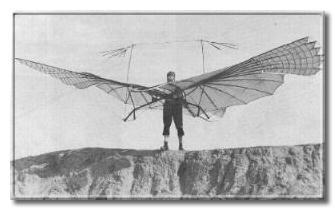Biosciences Seminar Series - Lent 2014
20 March 2014 - 1pm - Zoology Museum (Wallace 129)
 |
| Credit: Peter Preece www.peterpreece.com |
You may be wondering what evolutionary biomechanics is, exactly. Well, it is the study of evolution through the analysis of biomechanical systems, whith biomechanics focussing on the study of the structure and function of biological systems. Physical and biological constraints limit the 'design space' that natural selection can explore and hence adaptive evolution has to find solutions to trade-offs between complex and often conflicting performance objectives. The exciting aspect is that physical constraints and performance can often bre predicted with high precision from first principles.
 |
taken from: http://www.lilienthal-museum.de/olma/eotto.htm
|
The question of form and function comes quite naturally for the case of flight, for example avian flight. Humans have tried to emulate the design of bird wings to build gliders or planes and since the time of Otto von Lilienthal our empirical and theoretical understanding of aerodynamics and flight mehcanics has markedly increased, as has our knowledge about the morphology, ecology, and behaviour of flying animals, especially for birds. The similarities between the design of the wings of bats, birds, and flying dinosaurs (the pterosaurs) are also a classical example of convergent evolution.
 Our speaker this week, Prof. Adrian Toomas from the department of Zoology in Oxford, is an expert in this field. He has founded the Oxford Animal Flight Group in 1996, and his research deals with biological problems related to Fluid Dynamics and Flight Dynamics, especially how evolution tunes complex dynamical systems for high efficiency and efficacy of operation. To tackle these questions Adrian and his collegues use also engineering approaches, including the use of wind tunnels as well as high-frequency video recordings and tags to record the flight performances of animals in nature.
Our speaker this week, Prof. Adrian Toomas from the department of Zoology in Oxford, is an expert in this field. He has founded the Oxford Animal Flight Group in 1996, and his research deals with biological problems related to Fluid Dynamics and Flight Dynamics, especially how evolution tunes complex dynamical systems for high efficiency and efficacy of operation. To tackle these questions Adrian and his collegues use also engineering approaches, including the use of wind tunnels as well as high-frequency video recordings and tags to record the flight performances of animals in nature.Abstract:
Evolutionary design for flight defines the morphology of birds, and bird wing designs have become a classic example of convergent evolution. However, since before the start of aeronautical engineering it has been clear that the most aerodynamically advanced soaring birds fall into two distinct groups - birds that soar over land (like vultures) and birds that soar over the sea (like albatrosses). The evolutionary selection pressures leading to these two distinct groups have been a mystery. Recent research has shown that these two distinct solutions to the problem of soaring flight represent distinct solutions to the trade offs between multiple distinct performance objectives. Pareto-analysis allows us to objectively analyse this sort of multi-objective optimisation. The gradual diversification of species that so fascinated Darwin may be thought of as the process of finding alternative trade-offs among conflicting performance objectives in organisms subject to similar constraints. The distinction between vultures and albatrosses provides a first approach to unravelling that process.
Interested to hear more about that? Come and join us at 1pm in the Zoology Museum! Wallace building, room W129. Everyone most welcome.

No comments:
Post a Comment